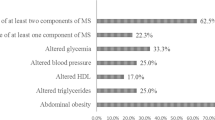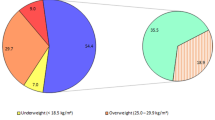Abstract
OBJECTIVE: To test association between overweight, central obesity and stature.
DESIGN: Cross-sectional study carried-out between 1990–1991.
SUBJECTS: 951 adults (387 male and 564 female) aged 20–64 y, resident in the metropolitan area of São Paulo, Brazil.
MEASUREMENTS: Anthropometry, blood lipid concentrations (total, high density lipoprotein (HDL) and low density lipoprotein (LDL)-cholesterol, triglycerides (TGs) and blood glucose. Body mass index (BMI), waist-to-hip ratio (WHR) and waist circumference were used to identify overweight (BMI >25 kg/m2), obdominal obesity (WHR tertile 3 and waist circumference tertile 3), respectively. The subjects were categorised as those of short stature (women <150 cm, men <162 cm) and those of normal stature (women ≥150 cm, men ≥162 cm).
RESULTS: Prevalence of short stature was 19.6% and 15.4% in men and women, respectively. Short stature women had higher serum concentrations of total cholesterol, LDL-cholesterol, TGs and glucose than those of normal stature. Among men, this difference was not observed, except for glucose concentrations. Short stature women had high BMI and WHR means in some age categories, compared with those of normal stature. Both overweight and high WHR frequencies were greater in short stature women than in those of normal ones. In multivariate analysis, adjusted by age, income, marital status, education, physical activity and tobacco use, only women group with short stature compared with normal stature had significantly risk of overweight an high WHR. In the same group there was no association with waist circumference. Among the men there was significant opposite association with waist circumference.
CONCLUSION: Short stature in women can potentially be an independent risk factor for overweight and high WHR.
This is a preview of subscription content, access via your institution
Access options
Subscribe to this journal
Receive 12 print issues and online access
$259.00 per year
only $21.58 per issue
Buy this article
- Purchase on Springer Link
- Instant access to full article PDF
Prices may be subject to local taxes which are calculated during checkout
Similar content being viewed by others
Author information
Authors and Affiliations
Corresponding author
Rights and permissions
About this article
Cite this article
Velásquez-Meléndez, G., Martins, I., Cervato, A. et al. Relationship between stature, overweight and central obesity in the adult population in São Paulo, Brazil. Int J Obes 23, 639–644 (1999). https://doi.org/10.1038/sj.ijo.0800895
Received:
Revised:
Accepted:
Published:
Issue Date:
DOI: https://doi.org/10.1038/sj.ijo.0800895
Keywords
This article is cited by
-
Gender, socio-economic status and metabolic syndrome in middle-aged and old adults
BMC Public Health (2008)
-
Socioeconomic Status in Relation to Obesity and Abdominal Obesity in Korean Adults: A Focus on Sex Differences*
Obesity (2006)
-
Lower resting metabolic rate and higher velocity of weight gain in a prospective study of stunted vs nonstunted girls living in the shantytowns of São Paulo, Brazil
European Journal of Clinical Nutrition (2005)
-
Food consumed does not account for the higher prevalence of obesity among stunted adults in a very-low-income population in the Northeast of Brazil (Maceió, Alagoas)
European Journal of Clinical Nutrition (2003)
-
Impact of birth weight on ethnic variations in subcutaneous and central adiposity in American children aged 5–11 years. A study from the Third National Health and Nutrition Examination Survey
International Journal of Obesity (2000)



